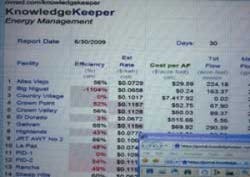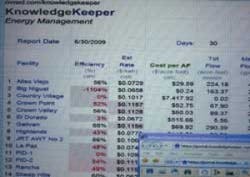By James Laughlin
Depending on who you ask, construction activity in the municipal water market will be up slightly, down slightly or flat in 2010. While the responses may vary by a few percentage points, what's clear is the industry won't see a quick recovery from the current economic downturn. And the federal stimulus program hasn't been all that stimulating.
"From what we are seeing in the markets we serve, there is some upward direction," said Bill Zieburtz, Director of Financial Consulting Services for JJG. However, "it is fair to say it is likely to be modest ... But there are projects that need to move forward and in spite of all the significant difficulties of funding, local governments are starting to get some things rolling ahead."
To gauge the health of the municipal water market and the outlook for construction activity in 2010, WaterWorld interviewed a select group of industry consultants and conducted a survey of water utility managers (see sidebar).
While remaining generally upbeat, the consultants agreed that the industry is far from recovered from the economic downturn.
"It's not easy to compare the industry today with the economic upturn we experienced in 2007/08," said Steve Wirtel, national director of client services for Carollo Engineers. "Even though we are seeing some indication of predictions that the overall market is starting to recover, based on what we're seeing in terms of design workload, we don't see an especially dramatic increase in 2010."
"Our industry tends to be a step or two behind the general economy," he said.
Stimulus Impact
The American Recovery and Reinvestment Act (ARRA) included $8 billion for water industry infrastructure, including $4 billion for wastewater and $2 billion for drinking water. However, the money was slow to impact the industry and in some cases delayed action as cities held up projects in hope of obtaining federal funding.
"The stimulus process may have given a short lived stimulation to the marketplace but nothing that showed a dramatic improvement or sustainable change," Wirtel said. "It may have cleared a small blockage in the line, but there is still a significant amount of work that needs to be done and there isn't funding for it."
"If you look at the estimates of the funding gap, it's on the order of 100s of billions to a trillion dollars, depending on which study you look at, so $8 billion is really an insignificant amount relative to what the industry needs to address all of its issues."
On the bright side, "There has been a little bit of impact as far as the consulting services business," said James A. Chaffee, North American Director for Water at AECOM. "There has been a frenzy of activity to line projects up to be eligible for stimulus funding and that has helped consultants, but overall the stimulus funding hasn't been huge."
According to a recent report from the House Transportation and Infrastructure Committee, the ARRA has launched $1.8 billion in projects through the Clean Water State Revolving Fund so far this year.
The committee said EPA has distributed to the states $3.98 billion of the $4 billion that the law authorized for the Clean Water fund. As of Sept. 30, the committee said 873 projects totaling $1.8 billion have been put out to bid in 43 states. Of those, 530 projects (totaling $1.1 billion) are already under contract and work has begun on 394 of them (totaling $872 million).
While those numbers are promising, it also means that a significant number of projects must have contracts awarded by the February 17, 2010, deadline or face losing their unspent money.
Part of the delay in getting projects moving was the long (and slow) buying cycle in the water industry. Passing the money through the SRF programs also slowed the process.
"A new funding program doesn't roll out that quickly," Zieburtz said. The stimulus program "necessarily had some delays, and that limited its ability to move as much forwarded as they wanted."
Industry Challenges
While it was difficult or expensive to borrow money during the early stages of the economic downturn, most of those problems have been resolved. Now, the issue is the collapse of the housing market, a general slowdown in economic activity and a decline in tax and fee revenues.
In some regions of the country, population growth and new development drove construction over the past several years, Zieburtz said.
"Because the South was growing at a rapid pace, that became the norm. It wasn't just water sales that were paying for projects, it was the growth – new development, tap or impact fees or other upfront charges that was making an awful lot of construction activity affordable and possible," Zieburtz said. "That is definitely going to be a challenge because that growth is not going to come back quickly."
"Utilities in the southeast have been suffering from an additional burden of the drought. Revenues dropped by 30 percent as a general average for utilities around here. It was certainly a severe hit," Zieburtz said.
As an off-shoot to the decline in new development and the economic downturn, water consumption is down in many areas of the country, and expected growth may not materialize in the years ahead. As a result, utilities may have to re-evaluate their long-term expansion plans, said Chaffee at AECOM.
Ziburtz had a similar thought: "Because utilities have lost industries or commercial sales in a lot of jurisdictions, demand is down. And if demand is down, where is the driver for new construction?"
Positive Signs
While work has slowed in some regions of the country, especially related to growth or expansion, the fact remains that US water infrastructure is aging. Work needs to move forward. And regulations and enforcement will continue to serve as drivers for construction.
"I think regulatory driven projects will continue," Chaffee said. "On the wastewater side, the SSO/CSO programs are funded and will continue ... We will also see issues related to TMDLs driving things like nutrient removal, especially in coastal areas."
In areas with water supply challenges, "there's a lot of interest in reuse and integrated water resources management. That activity is pretty steady," Chaffee said. "There are also some regulations driving reuse programs."
One positive aspect of the economic downturn – from the buyer's perspective – is a decline in construction costs.
"The good news is that if you've got the money, now is the best time in many years to bid construction work because of the level of competition and the costs coming back from contractors for new construction projects. We're advising our clients, if they can find money, don't delay, do the work now," Wirtel said.
Hot topics
As the industry looks forward, past this current downturn, a variety of new technologies and systems are being developed that could change the face of the water industry long-term.
"Certainly, the trend now is toward the water/energy nexus, so anything that we can do that is more efficient from an energy standpoint is going to be viewed as attractive technology to many of our clients," Wirtel said. "There is a trend to do more with less, so in some ways, (the economic downturn is serving as) a driver for those types of technologies."
"In the past, engineers took a macro approach to cleaning up sewage by adding significant energy inputs, primarily in the form of aeration for the biological treatment processes. Now we are starting to see a trend where engineers and utilities are starting to look at municipal wastewater as a resource: How can we extract the energy in the most efficient manner? How can we extract the nutrients so that we can recover and return those resources back into the agronomic cycle? How can we produce the highest quality water so it can be reused and recycled in the most efficient ways?" Wirtel said.
Virtually all of those interviewed cited energy efficiency as growing in importance for the water industry.
"There is a lot of interest and activity in energy related programs, especially energy recovery from biosolids, energy optimization at water and wastewater in general, and alternative energy sources," Chaffee said. " The projects are starting to make economic sense."
"Sustainability continues to be of continuing interest," said Zieburtz at JJG. "Some of issues that we haven't resolved as an industry are taking a back seat or being moved to a lower level because of the economy. Graying workforce is a good example. It's something critical for us to resolve, but the drive isn't there right now."
Funding
Although several bills are being considered in Washington to provide funding for water infrastructure, it is unlikely significant federal funding is on the horizon. Local funding for projects will remain the norm.
"From the standpoint of a utility manager, the prudent thing now is to take a back-to-basics approach," Ziburtz said. Pay as you go, "has the virtue of being much more predictable and much more in tune with the service the water and wastewater industry provides."
"Raising rates is a legitimate challenge. In our experience, it needs to be faced openly and explicitly," Zieburtz said. "As difficult as it is, the utilities that have made rate changes to insure adequate funding have not encountered devastating public opposition. People understand. Nobody wants to pay more for this type of service, but they understand the importance of the service and the infrastructure we provide."
Conclusion
While residential/commercial growth is temporarily stalled and municipal financing problems are a concern in some regions, the water industry is a large, fairly stable market that some view as almost recession proof.
"I think the market will be steady to up next year," Chaffee said. "We are seeing some competing forces; there's some softness due to the economy, but we're seeing that offset by the stimulus funding. While without the recession we might have seen greater growth, I think it (the water market) will still grow next year, perhaps 5-6 percent."
Wirtel was less optimistic: "I see 2010 as an improvement over 2009, but not to the levels we saw in 2007 and 2008," he said. "In 2010, much of the industry will be trying to recover from 2009. It may be a year or more before we get back to the market peaks we saw in the previous few years."
Ziburtz had a similar outlook: "We are seeing the inklings of recovery, but we have to look pretty far down the road to develop much optimism," he said.
"Ultimately, we know from our standpoint, our industry is necessary," Zieburtz said. "As the economy recovers, our industry will get back into (the construction) mode, we will extend services, we will build more capacity. The need for water and wastewater services will not go away or be exported." WW
Utility Managers Expect Increased Construction Activity
Water utility managers expect to see an increase in construction activity in 2010, both for the industry as a whole and for their specific utilities, with the majority of funding coming from a mix of local, state and federal sources, according to a survey conducted by WaterWorld.
The WaterWorld Industry Outlook survey was sent to magazine subscribers who list themselves as executive/management personnel at drinking water, wastewater and combined utilities across the country.
Respondents worked for utilities of all sizes, but the largest portion were managers at mid-sized combined water/wastewater utilities in the Midwest. The majority, 77.8%, said they were not planning a significant treatment plant project for 2010. Of those that were, the majority reported a capital budget for their project in the range of $10-$50 million.
Twenty-one percent expected to devote 50% or more of their capital budgets to pipe projects in 2010, while nearly the same percentage said they would devote more than 50% of their budgets to treatment plant upgrades. Automation system upgrades and water resource management projects were also expected to consume a significant percentage of budgeted capitol funds.
Of those responding, just over 60% expected moderate to greatly increased construction activity for the municipal water industry as a whole. Slightly over 26 percent predicted no change, while 13.2% expected less activity for the industry. When asked about their specific utilities, just over 57% predicted increased activity compared to 43% who expected the market to be flat or down slightly.
A majority (52.6%) felt the federal stimulus program had no significant effect on construction activity in their region for 2009, while nearly 32% felt it had helped jump-start projects. The balance felt it had actually slowed industry construction. Looking ahead to 2010, 56.8% felt the stimulus program would not help construction activity, while just over 43% hoped it would.
Exactly half of respondents expected to use a mix of local, state and federal funds to pay for construction projects in 2010, compared with 28.9 who planned to use only local funds. Just under 16% expected to use a mix of local and state funding.
Funding was listed as "very important" by a majority of respondents, as was energy efficiency. Other "important" topics included water conservation, system efficiency improvements and regulations.
More WaterWorld Current Issue Articles
More WaterWorld Archives Issue Articles




